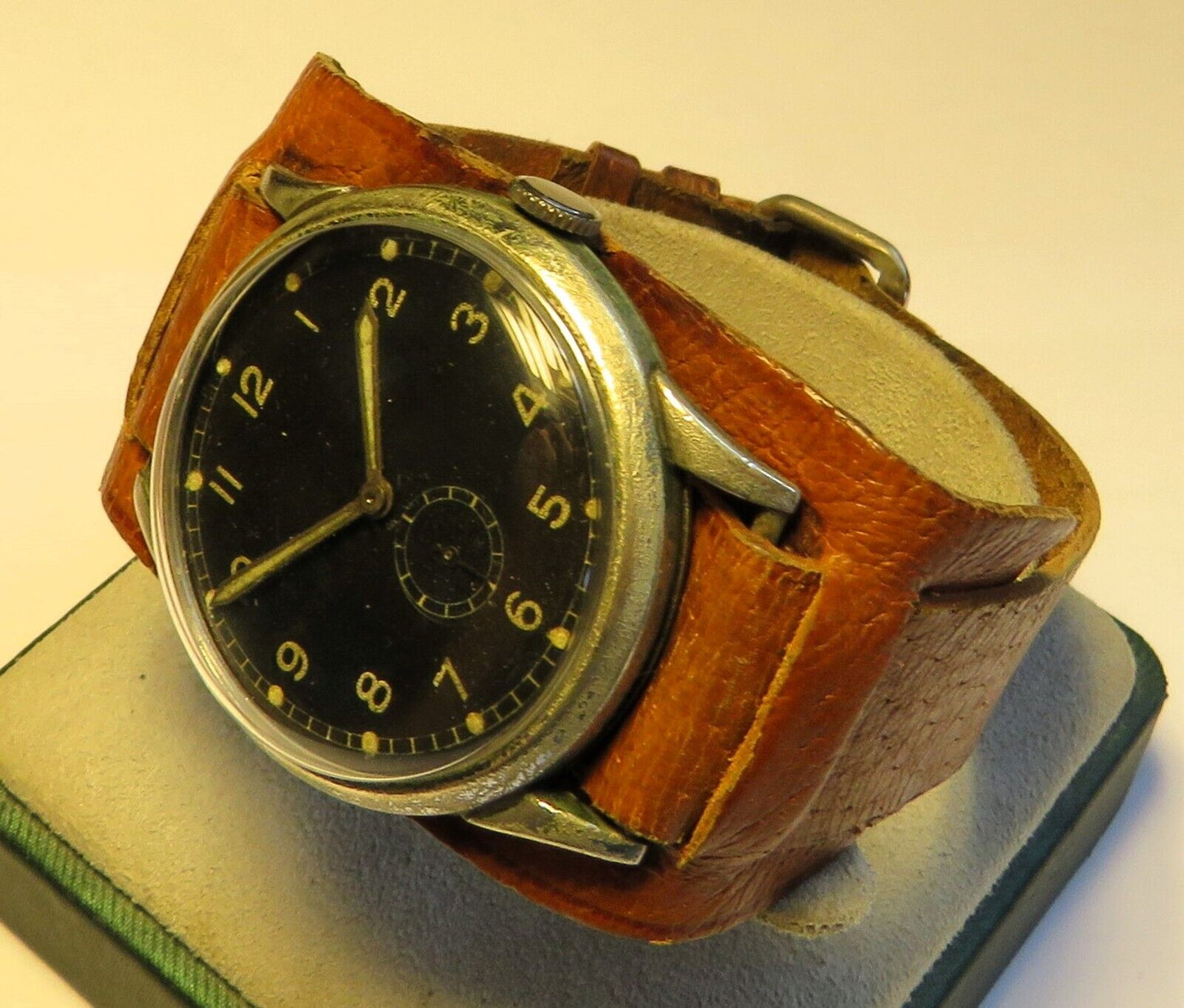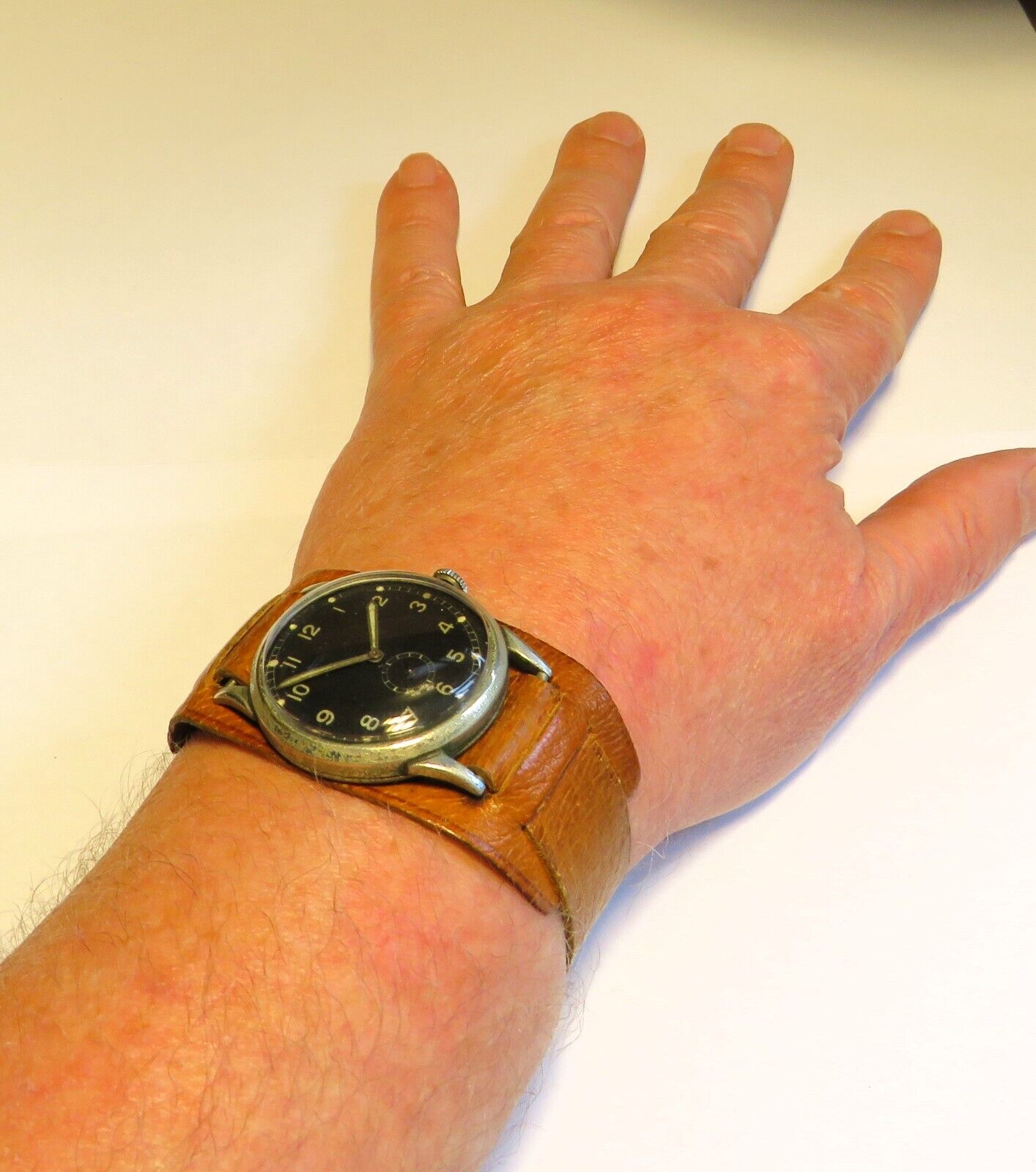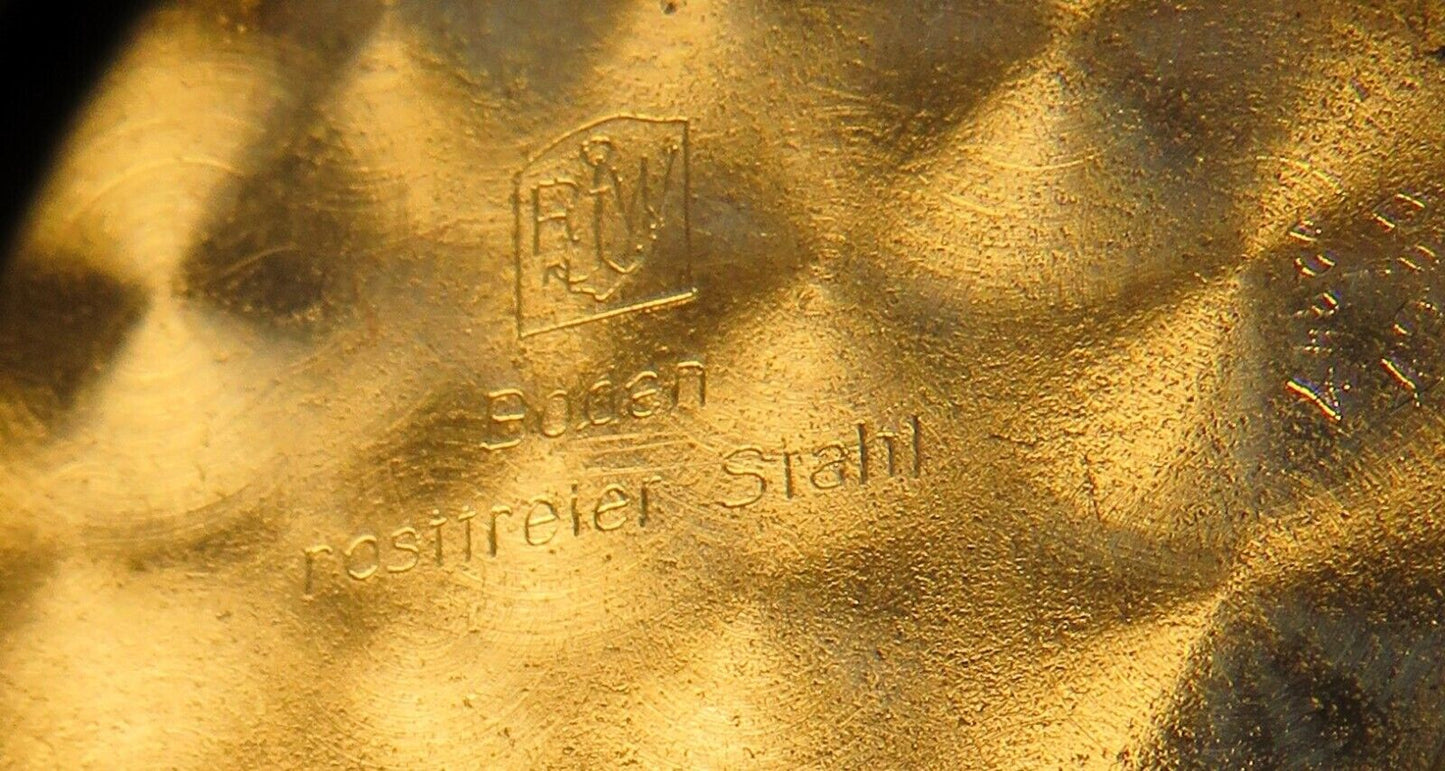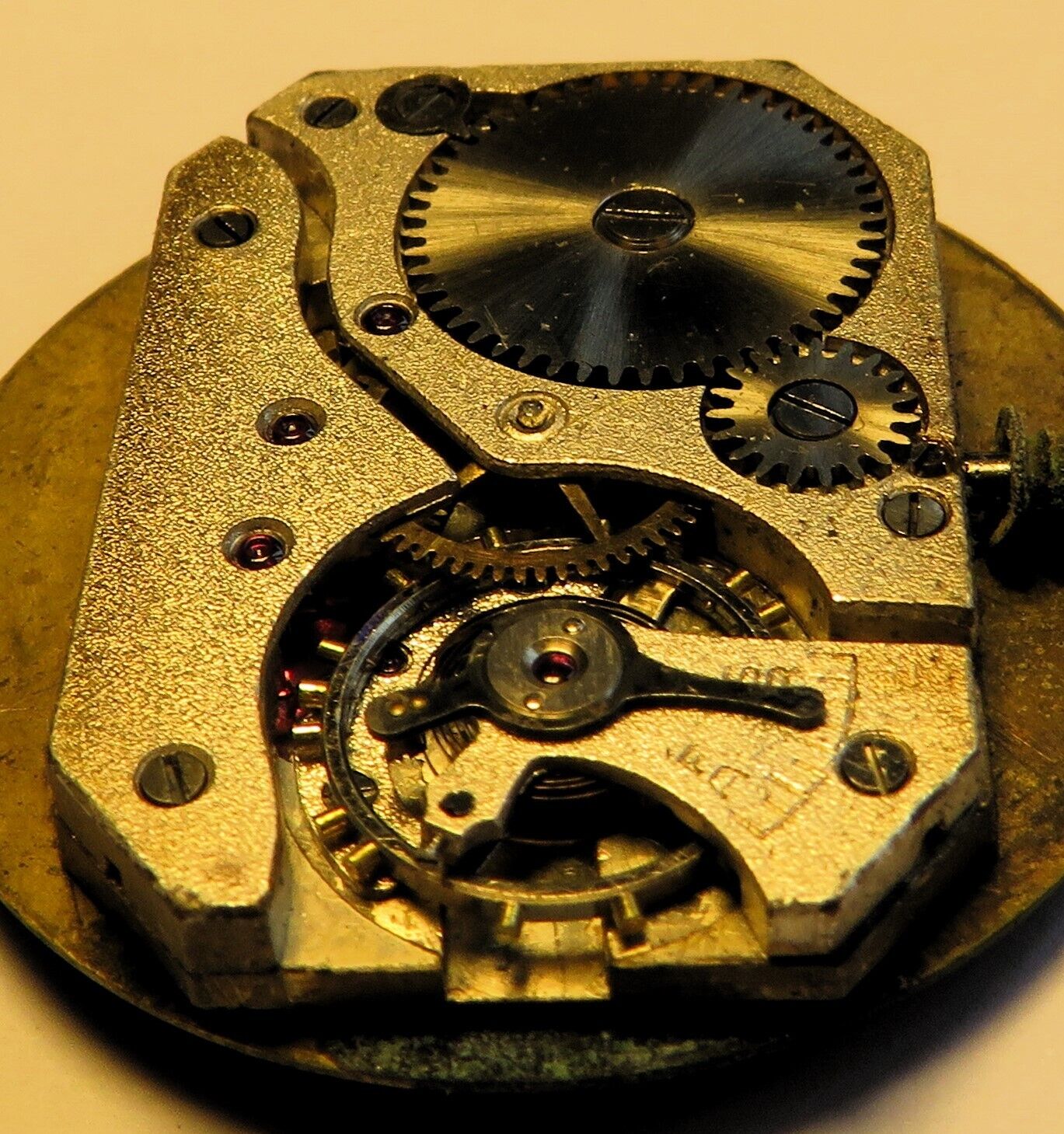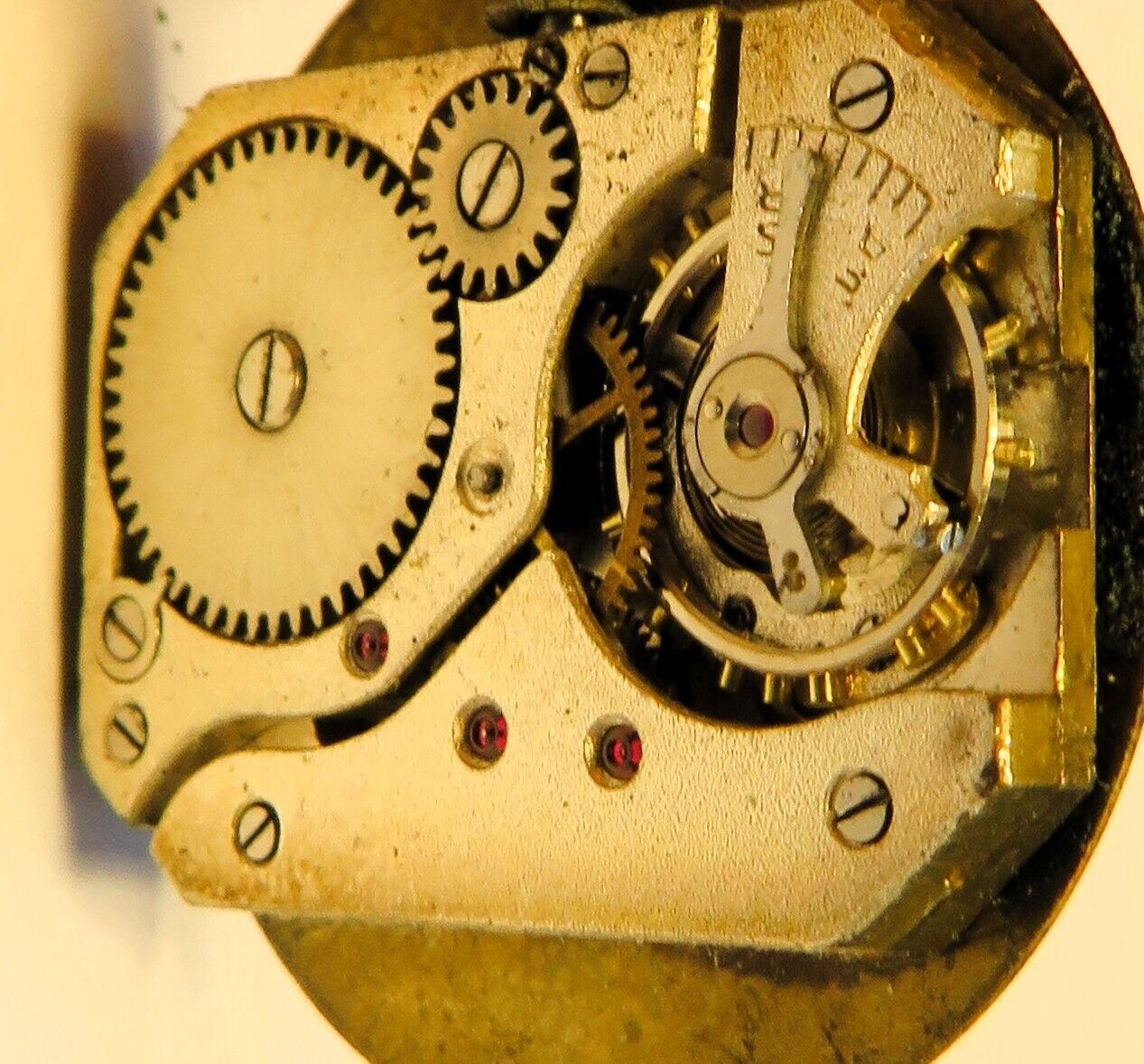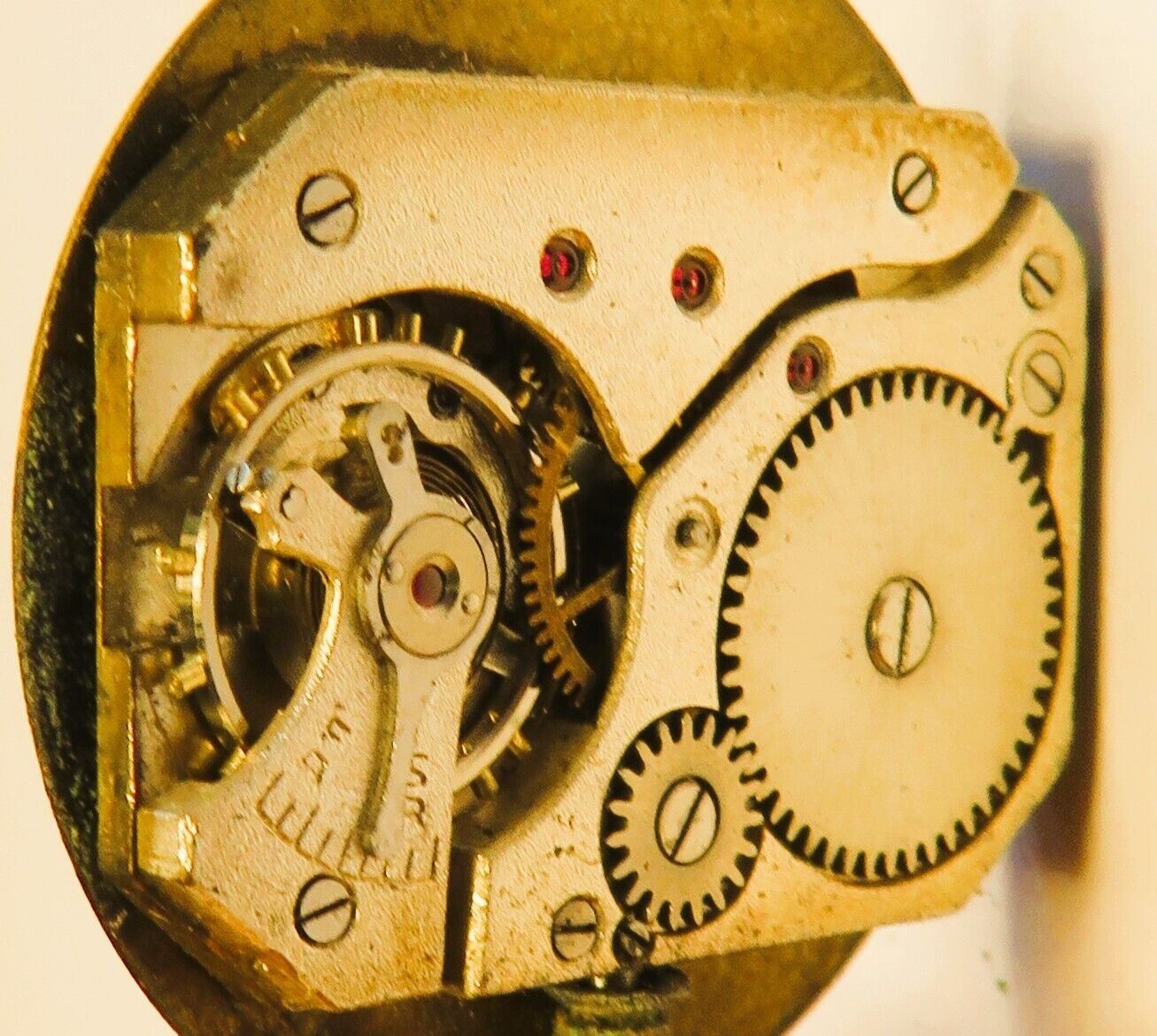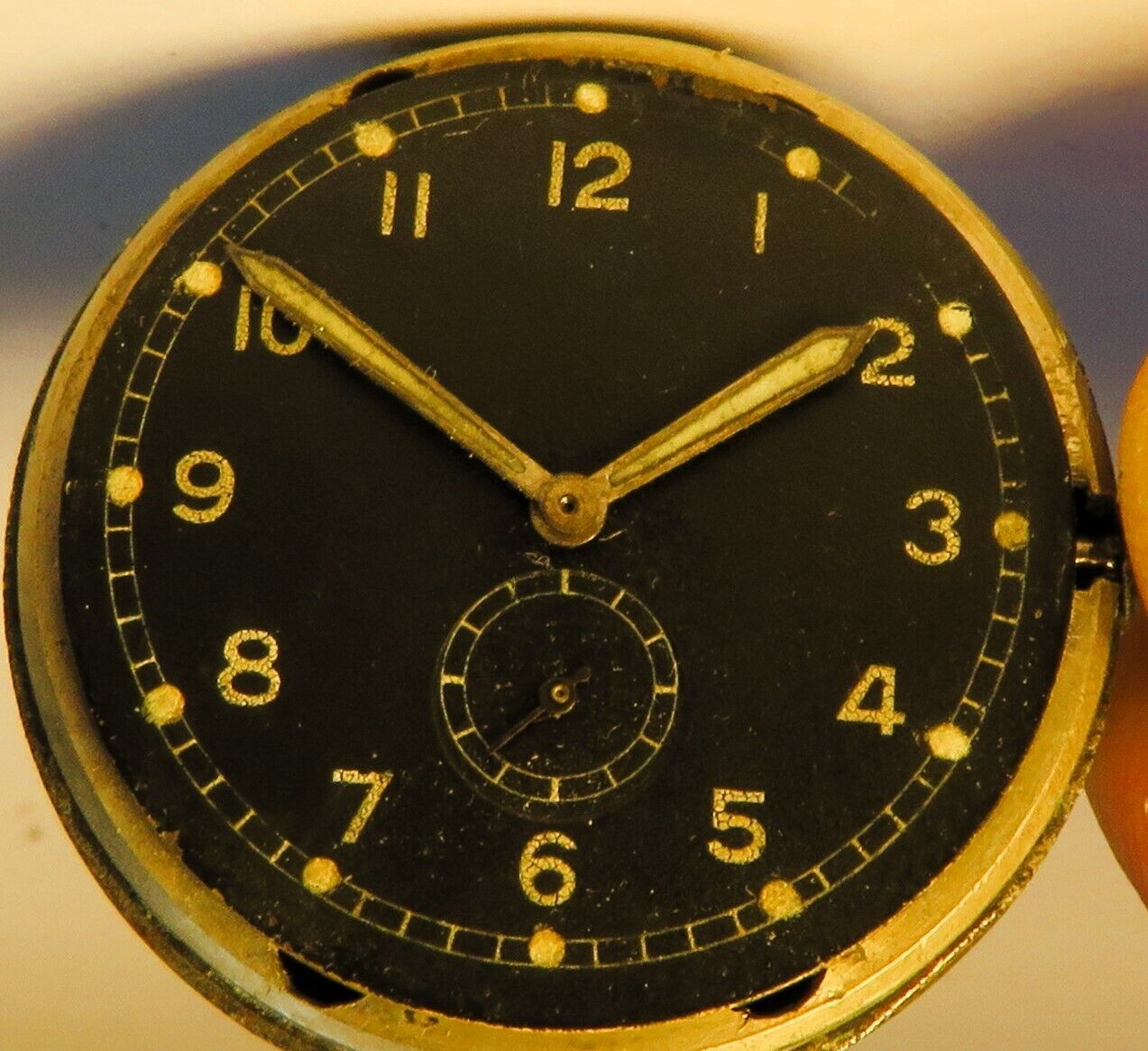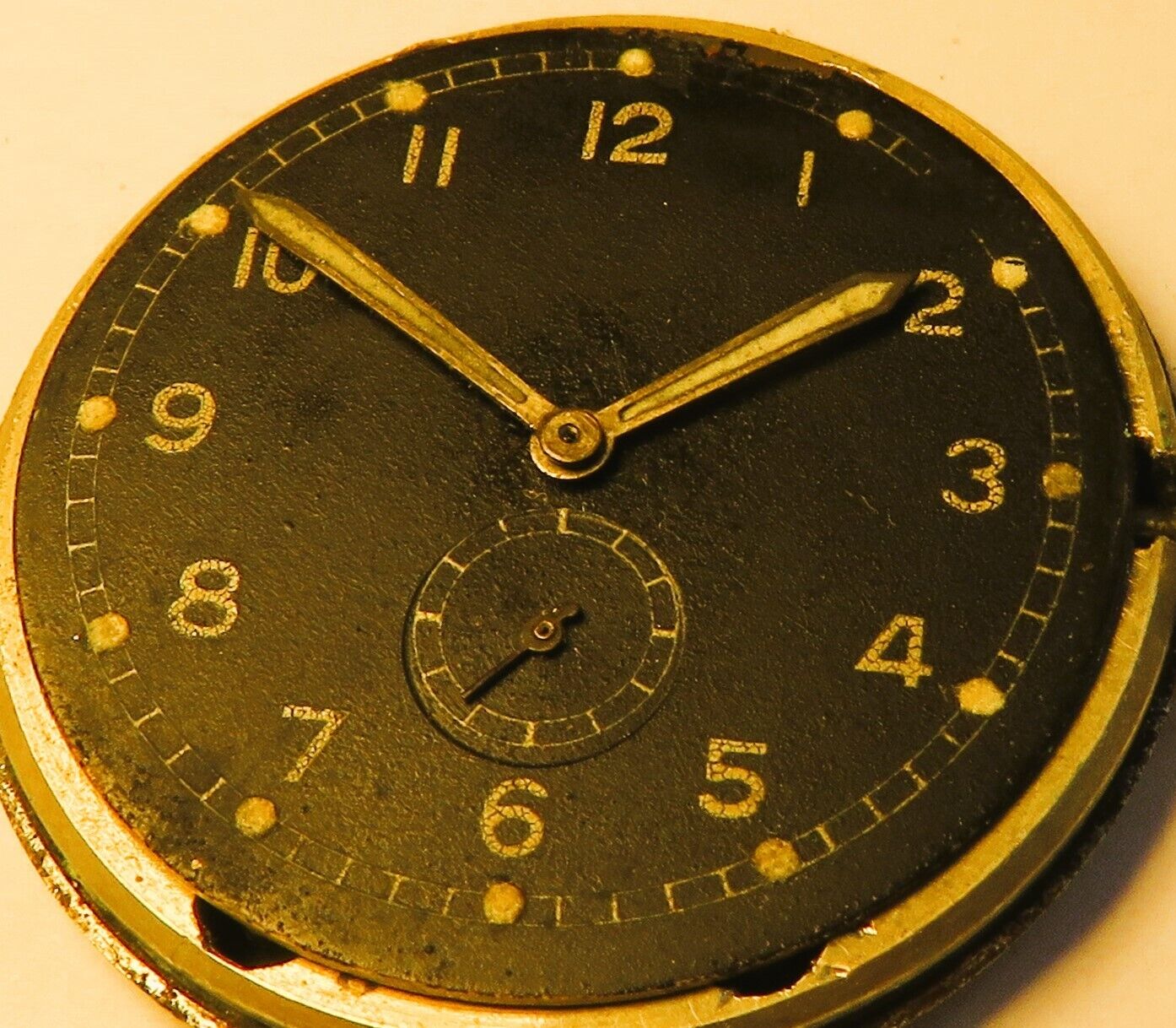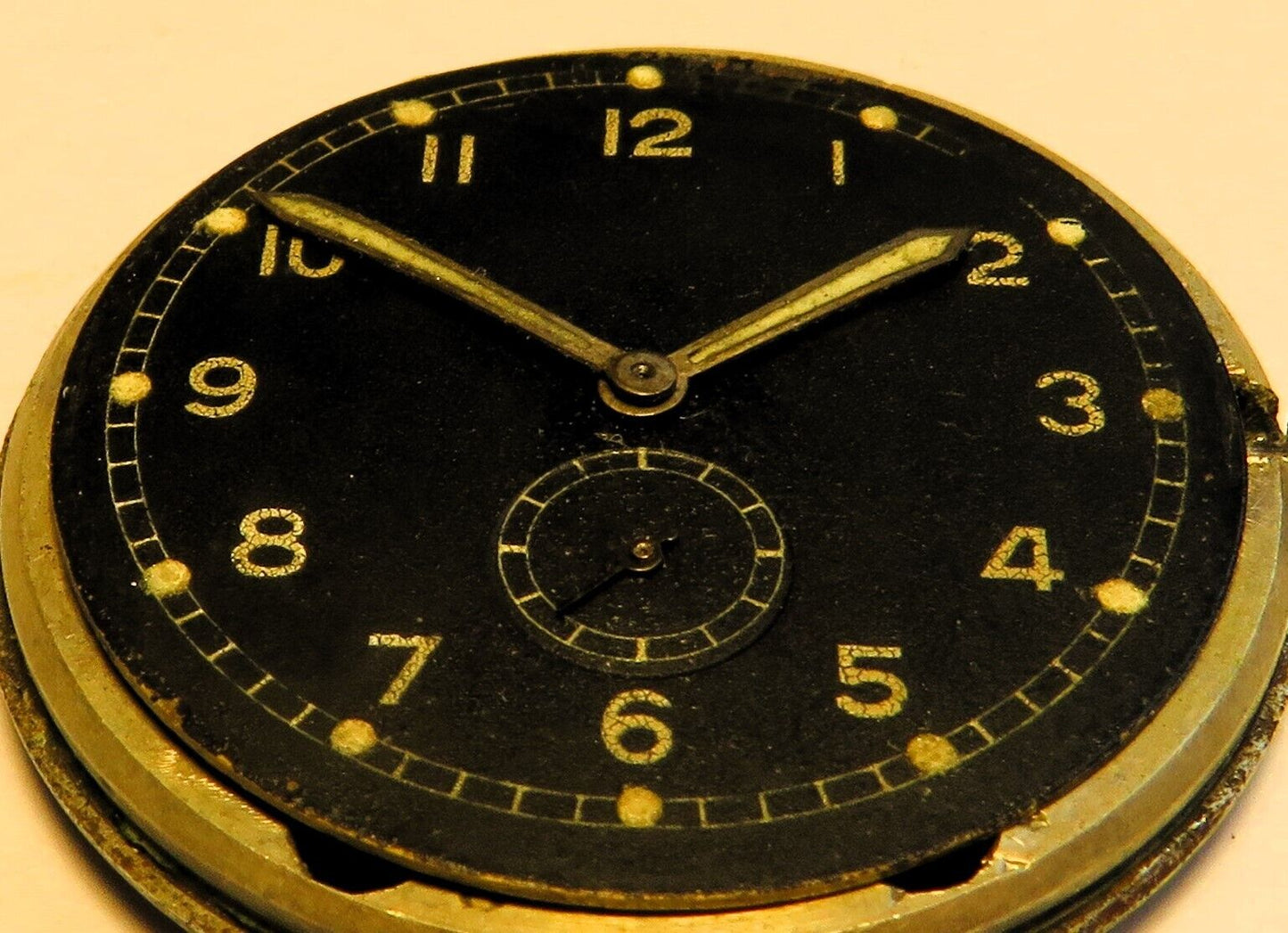Markenlos
Service watch Army Wehrmacht WW2 World War II Urofa 58 Raumnutzwerk Glashütte
Service watch Army Wehrmacht WW2 World War II Urofa 58 Raumnutzwerk Glashütte
Couldn't load pickup availability
Subject of the auction
Wehrmacht World War II service watch with the legendary Urofo 58 space-utility movement from Glashütte, functional
Case diameter: 34mm, black dial as specified for Wehrmacht service watches, Arabic numerals, fluorescent hands and dot indices, indirect second at the "6"
Pressed case back with engraving "Base Stainless Steel" typical for service watches
The watch is fitted with the legendary UROFA 58 "Raumnutzwerk" (space-utilizing movement). While the Urofa 58, along with Anton Schild's "AS 1130," is considered a "Wehrmacht movement" and was installed as a standard/ébauche movement in watches from various manufacturers and suppliers to the Wehrmacht, it is probably 100 times rarer than the "AS 1130."
You have to search for a long time to find an authentic Wehrmacht service watch on the Internet
The clear signs of use prove its military (front) use in World War II
Uninformed people might now complain and mutter "The bottom is not screwed" or "DH embossing is missing"
Friends of the Sun: "Wehrmacht Service Watch", not "Heer Service Watch"!!!
Not all Wehrmacht service watches were necessarily provided with screwed backs and "DH" stamped
You can easily read/compare this in Konrad Knirim's "Bible of Military Watches", where on page 377 the rarest and most valuable example of a Wehrmacht service watch is shown, the "Wagner Pforzheim Urofa 58", as well as models from Aeschbach, Aristo/Epple and Nila, all of which had a UROFA 58 space-utility movement and "only" a pressed case back.
All except the Wagner are signed RLM, precisely because they are not service watches of the Wehrmacht, but were delivered to the Reich Air Ministry
By the way, unsigned Wehrmacht service watches with UROFA 58 space-utility movement are much rarer and therefore more valuable than the army service watches that have the "DH" imprint; you can find them on every corner of the internet.
This rare piece of military watch history starts and runs (accuracy not tested)
EZ 2 - 3: runs and functions, clear signs of wear and oxidation on the case and back, but that's part of the authenticity of a service watch in WW2, unsigned dial top, new plastic glass, back sits rock solid
History of military wristwatches:
The history of the military wristwatch began in the last third of the 19th century. As late as the American Civil War (1861-1865), pocket watches were used exclusively, and even then only by officers who could actually afford such technical achievements. At this time, the first "real" wristwatches for women from various manufacturers already existed, but these were neither accurate nor robust enough for military use and were perceived at the time merely as a fashion gag and trend. The disadvantages of a pocket watch in the field or in combat are obvious: it took 10 seconds or more to pull it out of the pocket of the tight, thick uniform jacket. This period – extremely long in combat – could, in the worst case, result in a bullet hit and injury because one was distracted from the action in the decisive seconds and preoccupied with the pocket watch. Soldiers of various armies therefore increasingly began to insert pocket watches into homemade leather straps with sewn-on hollow straps so that they could be worn on the wrist and used at any time. It is considered certain that around 1880, a well-known Swiss manufacturer was the first manufacturer to win a tender among Swiss watch manufacturers and supplied the German Imperial Navy with pocket watches combined with such wristbands, which were initially used in naval attacks and naval battles involving several ships to synchronize the guns and salvos. In the Second South African Boer War (1899-1902), these very "leather cuff wrist/pocket watches" provided, alongside other military innovations such as smokeless gunpowder, the multi-shot magazine for assault rifles, and the first prototypes of machine guns. a decisive contribution to the victory of the technically superior British The first "test report" of these wristwatch models known in literature dates from this period: on June 7, 1900, a captain of the "Northern Staff Rgt" in the Boer War reported to his superiors: "I wore this "wristwatch" directly on my wrist for 3 1/2 months during my service at the front in South Africa. It kept excellent time and never let me down." It is documented that the early Imperial Air Force, even during the First World War (1914-1918), equipped its legendary fighter squadrons with such models as standard. The now industrially manufactured hollow leather cuffs were stamped on the back with the initials of the pilots or officers who owned them and the identification number of the respective fighter squadron. Several photos of Kaiser Wilhelm II from the period before 1918 have also survived, in which he proudly wears this earliest of all military wristwatch models with his uniform. Another decisive step was the invention in 1906 of an interchangeable and variable-length leather strap (for pilots to wear on the thigh over their flight suit) with soldered bars or wire loops, which allowed the threading of thin leather loops. This was the first so-called "under-the-cuff bracelet," some of which are still used today by the military or by divers. A major problem was the exclusively used Crystal glasses, which were very fragile and susceptible to impacts and splinters, especially in direct combat use. This was initially remedied from around 1910 onwards by simple cover plates with large holes (later metal grilles, called "shrapnel protection") to make the dial easier to see. There is a misconception that these grilles on the so-called "trench clocks" were designed to protect against shrapnel. This is, of course, nonsense! Neither wristwatch nor pocket watch, nor any grille in front of them, could withstand shrapnel. The protective grilles served as protection against mechanical forces and impacts during front-line work such as digging, carrying heavy beams during entrenchment, or operating, loading, and unloading artillery pieces with heavy projectiles. These early protective plates and grilles were initially self-made or manufactured by craftsmen from completely outside the industry, such as blacksmiths or metalworkers, and sold individually to the existing clock and, if necessary, resized: the legendary "trench clock" was born. Due to its distinctive and eye-catching design, the trench clock quickly became a status symbol for war heroes. and front-line soldiers and was worn and displayed with pride long after the war This upgrading to a status symbol similar to a medal, from the common soldier to the highest-ranking officer, also explains why these trench watches were produced long after the First World War, elaborately and artistically designed and the covers were usually made of silver, even though this metal was far too soft for front-line use The technical term for these trench watches became internationally established as "Half Hunter" (because only part of the dial was visible) or simply "Trench Watch". Despite all their military suitability and proven performance in front-line use, these early military watches were not "real" military wristwatches, but were all based on ladies' pocket watches or their movements. These early models did not make the leap to the civilian, "first market" and remained reserved for the military for almost two decades The main supplier of these pilot's pocket watches before and up until the end of the First World War was a Berlin manufacturer. This standard pilot's watch of the early Reichsluftwaffe was always signed "Property of the Air Force" on the dial and on the case back with the air force's "logo": the propeller with two lateral blades. The second major supplier of this watch type was the George Ducommun manufactory. The most striking feature of both models was the rotated dial, with the crown at the bottom and the indirect second hand at the top of the actual "12." With the outbreak of the First World War, the importance of and demand for robust and precise wristwatches changed rapidly! While the Imperial Army was still equipped with simple pocket watches in leather cuffs, which were worn on long straps over the flight suit or visibly hung in the leather cuffs in the cockpit, the Allied armies – encouraged by the positive experiences from the Anglo-Dutch Boer War in South Africa – were equipped with a wide range of small military pocket watches with interchangeable, fixed straps on fixed, soldered lugs. These small pocket watches had already been upgraded by the manufacturer for military use, some of which already had radium-filled, self-luminous hands and the "shrapnel protection grid" factory-applied, often even with a convenient folding hinge or removable. This type of first genuine military wristwatch was given "warlike" fantasy names by the manufacturers, such as "Mars" (from the Greek god of war Mars), Bellum, in further variations also Rellum, "Hindenburg," or in reference to the newly developed submarine weapon "U 29," "U21" etc., In addition, other features for military use, such as a small compass permanently embedded in the case, were developed and installed In Germany, these models were offered around 1950 at a price of 17 Reichsmarks (simple versions) to 37 Reichsmarks (for models with a second hand) They were sold and advertised professionally and also on the civilian market by companies such as "Siemann Armee und Marine Uhren" in Berlin, "Oswald Staerker" in Pforzheim, the "Deutschland Uhren Manufaktur Leo Frank", but also by the small manufacturers in Munich, Pforzheim and Glashütte, which later became very important In 1914, the worldwide demand for military wristwatches was at its first peak. Wristwatches were no longer a novelty or "gimmick", but an important piece of equipment for war. From around 1912 onwards, manufacturers could hardly keep up with the production of genuine military watches. The company that benefited most from this was Wilsdorf&Davis Ltd, founded in London in 1915 and later becoming an internationally renowned luxury watch manufacturer under the name best known for luxury watches today. In the early years, W&D only built movements it had bought in (e.g. from the Rehberg company, which it later took over) in cases it had also bought in, e.g. from Dennisson. Hans Wilsdorf, the founder and director of W&D, was the first strong advocate of wristwatches since the turn of the century. While others still scoffed at this new trend, Wilsdorf had already been experimenting for years with their precision, reliability and accuracy. It is said that the German Hans Wilsdorf did more for the development of the wristwatch we know today than anyone else in his field. Wilsdorf subjected his wristwatch movements to the most stringent examinations and stress tests. It was also he who came up with the idea of regularly sending his new developments to the Neuchatel Observatory (Switzerland) for further testing and can therefore be called the inventor of the chronometer or rather the chronometer test, which the best and highest quality watch manufacturers and models in the world still voluntarily undergo today. W&D received the first wristwatch chronometer awards from the School of Watchmaking in Biel (1910), and the Class "A" Certificate of Precision from the Kew Observatory in England (1914). To this day, W&D has more certificates from the Contrôle Officiel Suisse des Chronomètres (COSC) than all other watch manufacturers in the world combined. Even during the First World War, other manufacturers such as Franz Baumgartner, Borgel and Dennison recognized or anticipated the impending triumph of the new wristwatch and played their part in the development of ever better cases that were more resistant to splinters, shocks, dust and water. Further developments in the post-war period included the invention of solid, fixed metal bars that better protected the solid bezel around the case, glass and movement, as well as the indirect second with a sub-dial as a forerunner of the later and still common "central second". However, the development and presentation of the first truly waterproof wristwatch remained with W&D in 1926 with its wristwatch, which is still successful today and is known as the "Oyster". The next milestone in the military wristwatch was the early Swiss military watches with arrow index from 1928 to 1930. The forerunner of the From 1932 onwards, a chronograph with a second hand and zero setting was known – primarily for Luftwaffe pilots to calculate flight time, fuel consumption or supply, etc. – and around 1926, an unknown inventor and watchmaker invented and developed a rotating bezel with an applied arrow index. This original solution for pilots and flying personnel is not comparable with the diverse possibilities of a column wheel chronograph, but by setting the index arrow with the rotating bezel either to the time of departure or to the time until which the maximum fuel lasts, one has more or less precise and easily accessible information at any time, without having to pick up and use additional instruments or make separate notes. Other typical features of these models were extremely wide, curved lugs and the fact that they were almost never signed with national emblems, because according to the Treaty of Versailles, an air force was not permitted in Germany in the 1920s and for this reason was not allowed to appear as such and issue signed equipment. In fact, within two years, absolutely all well-known manufacturers in Germany and Switzerland produced these early pilot's watches with rotating knurled bezels and arrow indexing for exclusive military use. The person responsible for the development and procurement of these pieces of equipment was the legendary flying ace of the young Reichsluftwaffe (which existed and operated years before its official founding, contrary to the Treaty of Versailles), Ernst Udet, who was entrusted with this important task by his old flying comrade from the Jasta (fighter squadrons of the imperial air force) during the First World War and later Reich Minister of Aviation, Herman Göring. It is not known who invented this type of watch or which manufacturer produced it first. In the mid-1930s, this early pilot's watch of the Reichsluftwaffe was gradually replaced by real chronographs that had since been invented and the legendary B-watches with diameters of up to 60mm, which were worn over the pilot's uniforms. Starting in 1935, infantry and ground personnel received so-called "Wehrmacht Service Watches," which were produced and delivered by all manufacturers. These quasi-standard military watches were usually 35 cm in diameter, featured an indirect second hand, radium-filled hands and indices, and often also anti-magnetic soft iron protection for the movement. These Wehrmacht service watches were often signed with an abbreviation for the associated branch of service or Wehrmacht division, e.g., the letters "D" and "H" for "Deutsches Heer," "RLM" for Reichsluftfahrtministerium, "DAK" for "Deutsches Afrika Korps," or even just a "D" for Deutschland. Copyright 2010: Reiner Haas History of the Reichsluftwaffe's pilot watches: On January 30, 1933, Hermann Göring was appointed Reich Commissioner for Aviation, and on May 10, 1933, the "Reichsluftfahrtministerium" was founded. On May 1, 1933, approximately 550 aviation officers were recruited from the Army and Navy, forming the core of a third branch of the armed forces. The initial armament program of 1933 envisioned an air fleet of approximately 600 aircraft, with a focus on bomber squadrons. In March 1935, Reich Defense Minister Blomberg ordered the gradual unmasking of the Luftwaffe, which until then had been built up in secrecy due to the prohibition of the Treaty of Versailles. Robust, high-precision pilot's watches played a major role in the equipment of young fighter pilots from the very beginning. At the beginning of the 1930s, two factors played a key role in the selection and quality of pilot's watches: First, the wrist chronograph, which would later become commonplace in World War II, had only just been invented, and second, the Treaty of Versailles prohibited the existence of a Reich Air Force. For this reason, the early, and indeed the very first, pilot's watches were not signed or bearing any Reich Air Force markings. This first generation of pilot's watches of the Reichsluftwaffe were almost identical in size, design, and function: With a 40mm case diameter—the later size of the legendary Wehrmacht chronographs—slightly larger than "normal" service watches, they were generally equipped with a rotating, knurled bezel and index markings due to the lack of chronograph functions for precise measurement and display of flight duration. Wide, curved lugs and lugs, which extended far back to the rear, allowed them to be worn on a long strap over the pilot's overalls. All models of this period already possessed the typical features that later became standard for all Wehrmacht service watches: indirect second hand at the "6," a black dial, radium-filled hands, and Arabic numerals. Early pilot's watches with arrow indexes, all issued unmarked, were manufactured by virtually all renowned brands and supplied to the Reichsluftwaffe. Given that the Imperial Air Force's air corps and squadrons initially numbered only a few hundred pilots (although these models were also used by the several thousand-strong crews of the Reich Air Force), these rare early pilot's watches were produced in very small numbers and therefore fetch similar prices at specialist auctions today to the technically more sophisticated legendary B-Uhren and Wehrmacht chronographs, which were later produced in significantly larger numbers. In the mid-1930s, and from 1938 onward, major watch manufacturers developed and produced genuine pilot's chronographs as well as so-called B-Uhren (observation watches), which represented the absolute state of the art of watchmaking and technology at the time. Both versions of high-precision, military watchmaking had in common – compared to the so-called "Heer und Wehrmacht Dienstuhren" (Army and Wehrmacht Service Watches) – a significantly larger diameter of approximately 40 mm to 60 mm (B-Uhr). Until shortly before the end of the war, these legendary, rare, and coveted pilot's watches were signed by the now officially established Reichsluftwaffe with "RLM," "Reichsluftfahrtministerium," and often additionally engraved with "NAV B Uhr." However, starting in 1944, in the hustle and bustle of the looming loss of the World War, unsigned watches were also issued to the air force. Production of the B watches took place at various locations; for example, the dials were manufactured centrally and delivered by the Wehrmacht. In some cases, existing movements (e.g., from Durowe) were also installed. There were two versions of the legendary B-Uhr dial: first, from 1939, the version without an inner hour circle and with a triangle and two dots instead of the "12", and from 1943, the version with an inner hour circle without a triangle (for this version, the hour hand was made smaller). The reason for this was that it was discovered that the Luftwaffe mainly flew short missions and for this reason the indication and legibility of the minutes was much more important than that of the hours. From 1943 onwards, only the new dials with a large minute circle were used, and every time an older model was sent in for maintenance or repair, the dial was replaced at the same time. The earlier, larger hour hand was usually left on the watch because there weren't enough new, smaller hour hands in stock. For this reason, there are still a large number of B-Uhren with an inner hour circle and large hour hands. These examples are not "cobbled together," but rather represent an absolutely authentic piece of military watch history: originally built with a large hour circle and triangle, they were damaged in combat (e.g., a pilot crash or being hit by a grenade splinter). They were then repaired, the new dial was installed, and the old hour hand was retained due to a lack of spare parts. The legendary popularity and—in comparison to the number of active combat pilots—the high numbers produced of these magnificent pieces can be explained by the fact that, as state-of-the-art technology and also as status symbols, the B-Uhren and Fliegerchronographs were coveted, purchased, worn, and displayed by everyone from the officer corps to the general staff to the highest army command, the leaders and grandees of the Third Reich. With the introduction of the aforementioned pilot's watches, the High Command of the Luftwaffe, which was intensively rearming for the impending world war, established a distinction regarding the issue of pilot's watches between pilots and crew. While in the early 1930s, pilots, flight crews, and ground crews received and wore the same watches, the B-watches and chronographs were issued exclusively to pilots and bomb gunners, while the enlisted men and crews received smaller, much less elaborate service watches similar to those of the Herr and other combat units. Since the generally recognized Wehrmacht signature "DH" is clearly assigned to the "Heer Dienstuhren" (Heer Service Watches), it is now assumed that the signature "D" was intended for all Luftwaffe service watches. Thus, from approximately 1936 to 1944, Luftwaffe service wristwatches were marked either with "D," "RLM," or both. Before 1936 and from 1944 onward, they were also issued unsigned for the reasons already mentioned. The watches used were the "space-saving wonder" calibers UROFA 85, 58 and 581, developed specifically for mass production as part of the Luftwaffe's rearmament program in the mid/late 1930s, the so-called "Wehrmacht caliber" AS 1130 by Anton Schild, as well as the PUW (Pforzheimer Uhrenwerke) calibers 300 and 500, which were delivered centrally to the manufacturers, as well as the respective manufacturers' own movements. For collectors and enthusiasts of Wehrmacht watches, Luftwaffe pilot's watches are a special treat because they were produced in significantly smaller numbers than the Army and were sometimes considerably more robust and elaborately crafted, as well as having special additional functions such as a rotating bezel with indexing, a screwed-down stainless steel case back, shock protection or additional anti-magnetic soft iron protection. Very early and rare pilot's watches with arrow indexes often fetch prices at specialist auctions on a par with the legendary B-Uhren and Wehrmacht chronographs. Copyright 2007: Reiner Haas
An offer from the sole proprietorship Reiner Haas, Managing Director is Reiner Haas
Our company is taxed according to the differential taxation method, no VAT is shown in the final price
Cancellation policy
Right of withdrawal
You have the right to withdraw from this contract within fourteen days without giving any reason.
The cancellation period shall expire after fourteen days from the day on which you, or a third party other than the carrier designated by you, takes possession of the goods. To exercise your right of cancellation, you must notify us of your decision to cancel this contract by means of an unambiguous declaration (e.g., a letter sent by post, fax, or email). You may use the sample cancellation form below, but this is not mandatory.
The revocation must be addressed to:
Reiner Haas sole proprietorship
Rennmühle 3A, 91126 Schwabach
To comply with the cancellation period, it is sufficient that you send the notification of the exercise of the right of cancellation before the expiry of the cancellation period.
Consequences of revocation
If you cancel this contract, we will refund all payments that we have received from you, including delivery costs (with the exception of additional costs resulting from your choice of a delivery method other than the cheapest standard delivery offered by us), immediately and at the latest within fourteen days from the day on which we received notification of your cancellation of this contract.
For this refund, we will use the same means of payment that you used for the original transaction, unless something else was expressly agreed with you; under no circumstances will you be charged any fees for this refund.
We may refuse repayment until we have received the goods back or until you have provided evidence that you have returned the goods, whichever is the earlier.
whichever is earlier.
You must return or hand over the goods to us immediately and in any event no later than fourteen days from the date on which you notify us of the cancellation of this contract.
The deadline is met if you send the goods before the expiry of the fourteen-day period. You will bear the direct cost of returning the goods.
You only have to pay for any loss of value of the goods if this loss of value is due to handling of the goods which is not necessary to check their quality, properties and functioning.
If you wish to withdraw from the contract, please fill out this text template and send it back to:
Reiner Haas sole proprietorship
Rennmühle 3A
91126 Schwabach
I/we hereby revoke the contract concluded by me/us for the purchase of the following goods:
…............................................................................................................…................................................................................................................................................................................................................
Ordered on …......................................................
Received on …..................................................
Name of the consumer(s)
…........................................................................................
Address of the consumer(s)
…........................................................................................................….................................................................................................…..........................................................................................................…...........................................................................................................................................
Date and signature of the consumer(s) (only if notification is made on paper)
.........................................................................................................
EU Commission platform for online dispute resolution: https://www.ec.europa.eu/consumers/odr

